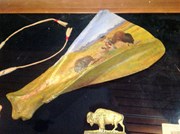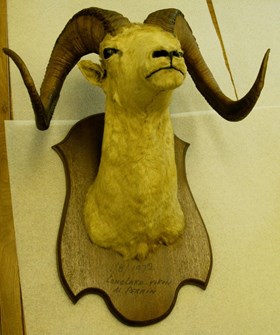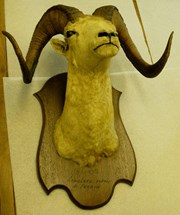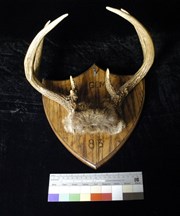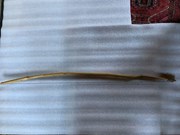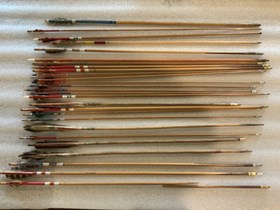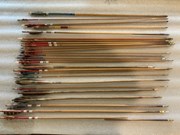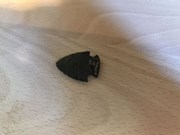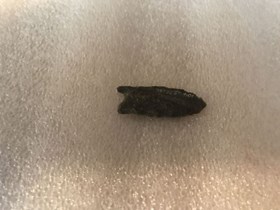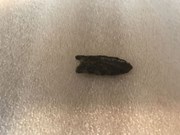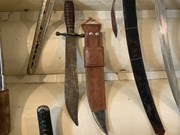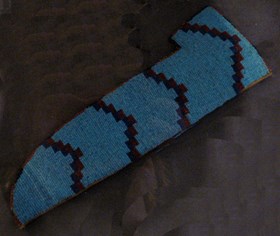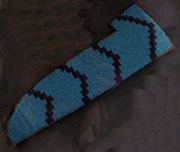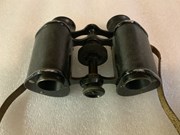Narrow Results By
- Date
- 1902 – 1902
- Material
- bone; oil paint; metal
- Catalogue Number
- 107.02.0018
- Description
- A bison hunting scene painted in oils on the shoulder blade of a buffalo. The scene is of a large expanse of yellow-green praries with mountains in the background and blue sky above with two bison running in opposite directions, one chased by figure on pony with bow and arrow cocked ready to shoot.…
1 image
- Title
- Painting
- Date
- 1902 – 1902
- Material
- bone; oil paint; metal
- Dimensions
- 23.0 x 11.0 x 47.5 cm
- Description
- A bison hunting scene painted in oils on the shoulder blade of a buffalo. The scene is of a large expanse of yellow-green praries with mountains in the background and blue sky above with two bison running in opposite directions, one chased by figure on pony with bow and arrow cocked ready to shoot. The work is signed “J.A. Dippie 1902” on the brc. The bone hangs from a chain attached at each side of the top. A paper sticker has been removed from the back with “A/TS HX/” showing beneath.
- Subject
- households
- crafts
- painting
- hunting
- animals, buffalo
- Credit
- Gift of Pearl Evelyn Moore, Banff, 1979
- Catalogue Number
- 107.02.0018
Images
This material is presented as originally created; it may contain outdated cultural descriptions and
potentially offensive content.
Read more.
Ovis Dalli Head
https://archives.whyte.org/en/permalink/artifact112.01.1018
- Date
- 1972
- Material
- skin; hair; keratin; glass; wood; metal
- Catalogue Number
- 112.01.1018
- Description
- A stuffed male thin horn sheep’s head (see cataloguer’s remarks) mounted on a wood plaque for hanging. The sheep head measures: 48.0cm from the neck to the top of the head; 55.0cm from the neck to the top of the horn; 44.0cm depth from neck to snout; and 59.0cm wide for the spread from horn tip to …
1 image
- Title
- Ovis Dalli Head
- Date
- 1972
- Material
- skin; hair; keratin; glass; wood; metal
- Dimensions
- 57.0 x 59.5 cm
- Description
- A stuffed male thin horn sheep’s head (see cataloguer’s remarks) mounted on a wood plaque for hanging. The sheep head measures: 48.0cm from the neck to the top of the head; 55.0cm from the neck to the top of the horn; 44.0cm depth from neck to snout; and 59.0cm wide for the spread from horn tip to horn tip. The sheep has two large backward curling horns (right horn: 89.50cmx 31.50cm wide, depth 11.0cm) (left horn: 91.25cmx32.0cm wide, depth 11.0cm). The horns are brown and tan and have been well used. The growth rings (called annuli) number 68. The fur is light brown and light tan on the muzzle and under the chin. The mouth is sewn shut leaving a black line that leads up to the black split nostrils. The eyeballs are glass and the eyelids are black rimmed; the black line extends well beyond the inside corner of the eyes. The head is mounted on a wood shield-shaped plaque and painted brown. Below the sheep’s head, printed on the wood shield in black ink with a felt-tipped pen is “1/8/1972”, underneath that, “LONGLAKE - YUKON”, and underneath that “AL PERRIN”. On the unpainted surface of the backside of the wood shield “AL PERRIN” is printed with a black ink felt-tipped pen, underneath that “Aug 1/72”, and underneath that “LONG LAKE YUKON”. There is a hole bored into the back, 2.50cm from the top, so it can be hung on a nail or screw. There are also three holes bored into the back, into which screws have been inserted, to adhere the head to the plaque. The measurements for the wood plaque are: 56.0cmx38.0cm wide (at its widest point), 31.0cm at its narrowest point and the depth is 2.0cm.
- Credit
- Gift of Albert Maitland Perrin, 2007
- Catalogue Number
- 112.01.1018
Images
This material is presented as originally created; it may contain outdated cultural descriptions and
potentially offensive content.
Read more.
- Date
- 1986
- Material
- keratin; skin; hair; wood; metal
- Catalogue Number
- 112.01.1019
- Description
- A pair of mounted deer antlers with part of the hair-covered head on a wood plaque. On viewer’s left the antler has two large points, one small point, and one projection (to be counted as a point the projection has to be over 1 inch). Viewer’s left: the first curved point closest to the viewer is 3…
1 image
- Title
- Deer Horns
- Date
- 1986
- Material
- keratin; skin; hair; wood; metal
- Description
- A pair of mounted deer antlers with part of the hair-covered head on a wood plaque. On viewer’s left the antler has two large points, one small point, and one projection (to be counted as a point the projection has to be over 1 inch). Viewer’s left: the first curved point closest to the viewer is 34.0cm in length; it is dividing at the end with a 2.0cm length projection. The curved point behind is 30.5cm; at the base of the antler it has a 9.0cm point with a 1.0cm projection. On the viewer’s right the curved antler has three points. At the base of the antler the smallest point is 12.0cm; the inward curving point closest to the viewer’s right measures 39.0cm in length and the one behind is 33.25cm in length. The depth of each antler is 10.0cm. The point span at its largest is 29.50cm, the next 28.0cm. The head part has brown/red hair, with much lighter hair on each side. The top of the head part between the antlers is 7.50cm; the base is 12.7cm. Measurements for the head part is 9.0cm x12.0cm wide, and depth 5.0cm. There are two screws through the head part to attach the antlers to the plaque. The screw on the viewer’s left, is 4.0cm from the head part base and the screw on the viewer’s right is 5.0cm from the head part base. The plaque is a shield-shaped piece of dark brown varnished wood measuring 28.0cmx26.0cm wide, and 1.0cm depth. There is a screw 3.0cm from the top to attach it to the wall. Underneath this the word “GEM” is carved into the wood. At the bottom of the plaque underneath the antlers and head part the number “86” is carved.Note: These antlers are screwed to the wall of the ‘Trading Post’ in the Luxton exhibition “Stuff of Legend” so it was hard to measure.
- Credit
- Gift of Albert Maitland Perrin, 2007
- Catalogue Number
- 112.01.1019
Images
This material is presented as originally created; it may contain outdated cultural descriptions and
potentially offensive content.
Read more.
- Date
- 1910 – 1930
- Material
- wood; sinew; fibre
- Catalogue Number
- 104.05.0002
- Description
- A sturdy bow carved from a piece of wood and shaped allowing for knots in the wood (almost a reverse curve at one end). A twisted sinew cord is looped around a notch at one end and wrapped around the bow many times at the other end.
1 image
- Title
- Bow
- Date
- 1910 – 1930
- Material
- wood; sinew; fibre
- Dimensions
- 115.0 cm
- Description
- A sturdy bow carved from a piece of wood and shaped allowing for knots in the wood (almost a reverse curve at one end). A twisted sinew cord is looped around a notch at one end and wrapped around the bow many times at the other end.
- Subject
- Indigenous, Stoney
- hunting
- households
- Credit
- Gift of Pearl Evelyn Moore, Banff, 1979
- Catalogue Number
- 104.05.0002
Images
This material is presented as originally created; it may contain outdated cultural descriptions and
potentially offensive content.
Read more.
- Date
- 1910 – 1950
- Material
- wood; metal; plastic; feather; paint
- Catalogue Number
- 104.05.0003 a-z, aa
- Description
- A set of twenty-seven arrows: - Four handmade wooden arrows with three feathers at one notched end. The other end of each arrow is sharpened to a point. There are coloured bands painted under the feathers. - Ten very thin wooden arrows with pointed metal tips. The notched end of each arrow has s…
1 image
- Title
- Arrow
- Date
- 1910 – 1950
- Material
- wood; metal; plastic; feather; paint
- Dimensions
- 72.0 (average) cm
- Description
- A set of twenty-seven arrows: - Four handmade wooden arrows with three feathers at one notched end. The other end of each arrow is sharpened to a point. There are coloured bands painted under the feathers. - Ten very thin wooden arrows with pointed metal tips. The notched end of each arrow has small feathers and painted coloured bands. Four of these arrows are marked “South Bend Quality Tackle Bait Co.”. Two of these arrows are marked “The Oreno Pat. Pending”.- Five wooden arrows with pointed metal tips. These arrows have red, yellow and white bands at the feathered end. One of these arrows has a pointed spike projecting from the tip. These arrows are marked “made in U.S.A. Rounsville-Pohm, Hazel Crest, Ill. 29”. - Two wooden arrows with pointed metal tips at one end, and plastic notches at the other. There are red, white, blue and yellow bands at the notched end of each arrow. - Two arrows with blue and white bands at the notched feathered end. These arrows have a darker harder wood piece, with a metal tip, scarfed to the other end.- One handmade arrow, in the manner of Indigenous arrows, that is painted blue at the notched end. The opposite end is sharpened to a point. - Three odd arrows: one arrow with a plastic tip and faded blue bands at the notched, feathered end; one arrow with a red and yellow band at the notched feathered end and metal tip; one arrow that was once painted completely red with plastic notch and metal tip (no feathers).
- Subject
- Indigenous
- hunting
- households
- sports, archery
- Credit
- Gift of Pearl Evelyn Moore, Banff, 1979
- Catalogue Number
- 104.05.0003 a-z, aa
Images
This material is presented as originally created; it may contain outdated cultural descriptions and
potentially offensive content.
Read more.
Projectile Point
https://archives.whyte.org/en/permalink/artifact104.05.0016%20a-c
- Date
- n.d.
- Material
- stone
- Catalogue Number
- 104.05.0016 a-c
- Description
- Three projectile points, possibly made of slate:a) A flaked projectile point that is oval in shape and has no shaft. b) A flaked, arrow-shaped, projectile point with steep sides, definite shoulders and a small shaft. c) A flaked, wide shouldered, very dark coloured projectile point. The edges of t…
1 image
- Title
- Projectile Point
- Date
- n.d.
- Material
- stone
- Dimensions
- 6.5 (a); 5.7 (b); 3.0 (c) cm
- Description
- Three projectile points, possibly made of slate:a) A flaked projectile point that is oval in shape and has no shaft. b) A flaked, arrow-shaped, projectile point with steep sides, definite shoulders and a small shaft. c) A flaked, wide shouldered, very dark coloured projectile point. The edges of the projectile point curve in from the shoulders, and then out to a slightly flaring shaft.
- Subject
- Indigenous
- hunting
- households
- Credit
- Gift of Pearl Evelyn Moore, Banff, 1979
- Catalogue Number
- 104.05.0016 a-c
Images
This material is presented as originally created; it may contain outdated cultural descriptions and
potentially offensive content.
Read more.
Projectile Point
https://archives.whyte.org/en/permalink/artifact104.05.0019%20a-c
- Date
- n.d.
- Material
- stone, quartzite
- Catalogue Number
- 104.05.0019 a-c
- Description
- Three quarzite arrowheads:a) A flaked quartzite point in the shape of a rough arrow with slightly convex sides. This point has no shaft. b) A flaked quartzite point in the shape of an arrow with slightly articulated shoulders leading to a fairly wide shaft.c) A flaked quartzite point shaped like a…
1 image
- Title
- Projectile Point
- Date
- n.d.
- Material
- stone, quartzite
- Dimensions
- 3.5 (a); 3.5 (b); 4.5 (c) cm
- Description
- Three quarzite arrowheads:a) A flaked quartzite point in the shape of a rough arrow with slightly convex sides. This point has no shaft. b) A flaked quartzite point in the shape of an arrow with slightly articulated shoulders leading to a fairly wide shaft.c) A flaked quartzite point shaped like a parabola with a notch at one end.
- Subject
- Indigenous
- hunting
- households
- Credit
- Gift of Pearl Evelyn Moore, Banff, 1979
- Catalogue Number
- 104.05.0019 a-c
Images
This material is presented as originally created; it may contain outdated cultural descriptions and
potentially offensive content.
Read more.
- Date
- 1850 – 1900
- Material
- metal, steel; metal, brass; skin
- Catalogue Number
- 104.05.0026 a,b
- Description
- A strong, single edged hunting knife with a cross piece. The hilt of the knife is made of brass, and covered with leather. The blade is marked “Collins and Co. Hartford Serofino #17 (Galidad)”. (b) Sheath made of leather with steel tip and steel detailing. Leather is embossed with crown and leav…
1 image
- Title
- Bowie Knife
- Date
- 1850 – 1900
- Material
- metal, steel; metal, brass; skin
- Dimensions
- 4.5 (widest point) x 37.0 cm
- Description
- A strong, single edged hunting knife with a cross piece. The hilt of the knife is made of brass, and covered with leather. The blade is marked “Collins and Co. Hartford Serofino #17 (Galidad)”. (b) Sheath made of leather with steel tip and steel detailing. Leather is embossed with crown and leaves. “LEGITIMUS” is stamped under the crown and the number ”10” is stamped on a cross piece above.
- Subject
- households
- hunting
- Credit
- Gift of Pearl Evelyn Moore, Banff, 1979
- Catalogue Number
- 104.05.0026 a,b
Images
This material is presented as originally created; it may contain outdated cultural descriptions and
potentially offensive content.
Read more.
- Date
- 1885 – 1920
- Material
- skin; glass
- Catalogue Number
- 104.10.0003
- Description
- A very simply shaped sheath made to hold a knife. The back of the sheath is plain moosehide with a large belt loop at the centre made from a 3 cm wide strip of hide. Part of the top of the case that extends to one side. The front of the sheath is completely beaded with a light blue background and…
1 image
- Title
- Knife Sheath
- Date
- 1885 – 1920
- Material
- skin; glass
- Dimensions
- 7.5 x 31.0 cm
- Description
- A very simply shaped sheath made to hold a knife. The back of the sheath is plain moosehide with a large belt loop at the centre made from a 3 cm wide strip of hide. Part of the top of the case that extends to one side. The front of the sheath is completely beaded with a light blue background and four chevron shaped lines made up of small squares of red and dark blue beads. A rolled beaded edging of red and dark blue beads runs along the curved side and across the top of the sheath.
- Credit
- Gift of Pearl Evelyn Moore, Banff, 1979
- Catalogue Number
- 104.10.0003
Images
This material is presented as originally created; it may contain outdated cultural descriptions and
potentially offensive content.
Read more.
- Date
- 1910 – 1920
- Material
- skin; metal; glass; plastic; fibre
- Catalogue Number
- 104.38.0003 a,b
- Description
- A pair of binoculars (a) in a case (b).a) A pair of black leather binoculars with a brass frame and plastic eyepieces. A hinge on the arm at the middle adjusts the lenses to eye width. The focus is adjusted by a large notched plastic wheel on the arm. Further adjustment can be made by twisting …
1 image
- Title
- Binoculars
- Date
- 1910 – 1920
- Material
- skin; metal; glass; plastic; fibre
- Dimensions
- 11.5 (a); 14.1 (b) x 5.0 (a); 7.5 (b) x 10.0 (a); 12.0 (b) cm
- Description
- A pair of binoculars (a) in a case (b).a) A pair of black leather binoculars with a brass frame and plastic eyepieces. A hinge on the arm at the middle adjusts the lenses to eye width. The focus is adjusted by a large notched plastic wheel on the arm. Further adjustment can be made by twisting the right eyepiece, with a scale reading “_5 0 + 5”. A narrow leather strap is attached to brass eyes on the body of the binoculars On the left side is “Voigtlander & Sohn Braunschweig & London No. 3380”b) The binocular case is tan-coloured leather with a flip top lid that is secured with a strap that buckles through a leather covered buckle on the front. There are leather straps on the back, to secure the case to a belt, and a neckstrap attached to the sides of the case. The case is lined with red velvet and built up inside to fit the binoculars securely. The case bears the handwritten initials “-.H.W.” and a date (1911?).
- Credit
- Gift of Pearl Evelyn Moore, Banff, 1979
- Catalogue Number
- 104.38.0003 a,b
Images
This material is presented as originally created; it may contain outdated cultural descriptions and
potentially offensive content.
Read more.


